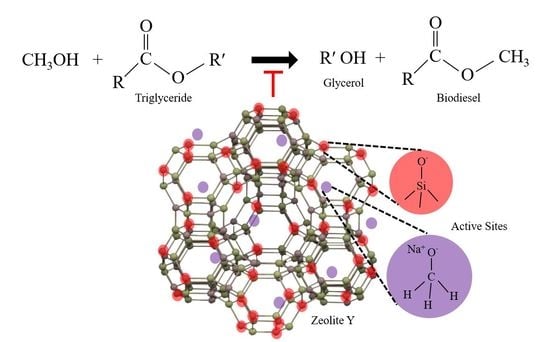Sodium Methoxide/Zeolite-Supported Catalyst for Transesterification of Soybean Waste Cooking Oil for Biodiesel Production
Abstract
:1. Introduction
2. Results and Discussion
2.1. Catalyst Characterization
2.1.1. Fourier Transform Infrared Spectroscopy (FT–IR)
2.1.2. X-ray Diffraction (XRD)
2.1.3. BET Surface Area
2.1.4. Scanning Electron Microscopy (SEM)
2.1.5. Transmission Electron Microscopy (TEM)
2.2. Catalytic Screening
2.3. Catalyst Activity
2.3.1. Effect of Methanol Volume on Biodiesel Yield
2.3.2. Effect of Catalyst Amount on Biodiesel Yield
2.3.3. Effect of Time on Biodiesel Yield
2.3.4. Effect of Temperature on Biodiesel Yield
2.4. Plausible Mechanism of Transesterification of WCO
2.5. Biodiesel Characterization
2.5.1. Fourier Transform Infrared Spectroscopy (FT–IR)
2.5.2. Nuclear Magnetic Resonance (H-NMR)
2.5.3. Viscosity
3. Materials and Methods
3.1. Materials
3.2. Catlayst Preparation
3.3. Transesterification Procedure
4. Conclusions
Author Contributions
Funding
Data Availability Statement
Conflicts of Interest
References
- Oerther, S.E.; Rosa, W.E. Advocating for equality: The backbone of the sustainable development goals. Am. J. Nurs. 2020, 120, 60. [Google Scholar] [CrossRef] [PubMed]
- IEA. IEA Key World Energy Statistics 2021—Analysis, IEA. Available online: https://www.iea.org/reports/key-world-energy-statistics-2021 (accessed on 8 April 2023).
- Degfie, T.A.; Mamo, T.T.; Mekonnen, Y.S. Optimized Biodiesel Production from Waste Cooking Oil (WCO) Using Calcium Oxide (Cao) Nano-Catalyst. Sci. Rep. 2019, 9, 18982. [Google Scholar] [CrossRef] [PubMed] [Green Version]
- Jaichandar, S.; Annamalai, K. The status of biodiesel as an alternative fuel for diesel engine—An overview. J. Sustain. Energy Environ. 2011, 2, 71–75. [Google Scholar]
- Encinar, J.M.; González, J.F.; Sabio, E.; Ramiro, M.J. Preparation and properties of biodiesel from Cynara cardunculus L. oil. Ind. Eng. Chem. Res. 1999, 38, 2927–2931. [Google Scholar] [CrossRef]
- Marchetti, J.M.; Miguel, V.U.; Errazu, A.F. Possible methods for biodiesel production. Renew. Sustain. Energy Rev. 2007, 11, 1300–1311. [Google Scholar] [CrossRef]
- Notz, R.J.; Toennies, I.; McCann, N.; Scheffknecht, G.; Hasse, H. CO2 Capture for Fossil Fuel-Fired Power Plants. Chem. Eng. Technol. 2011, 34, 163–172. [Google Scholar] [CrossRef]
- Joshi, J.R.; Bheri, K.K.; Patel, J.V. Waste cooking oil as a promising source for bio lubricants-A review. J. Indian Chem. Soc. 2022, 100, 100820. [Google Scholar] [CrossRef]
- Kulkarni, M.G.; Dalai, A.K. Waste cooking oil an economical source for biodiesel: A review. Ind. Eng. Chem. Res. 2006, 45, 2901–2913. [Google Scholar] [CrossRef]
- Islam, A.; Taufiq-Yap, Y.H. Advanced Technologies in Biodiesel: New Advances in Designed and Optimized Catalysts; Momentum Press: New York, NY, USA, 2015. [Google Scholar]
- Bezergianni, S.; Dimitriadis, A.; Kalogianni, A.; Pilavachi, P.A. Hydrotreating of waste cooking oil for biodiesel production. Part I: Effect of temperature on product yields and heteroatom removal. Bioresour. Technol. 2010, 101, 6651–6656. [Google Scholar] [CrossRef]
- Bezergianni, S.; Dimitriadis, A.; Sfetsas, T.; Kalogianni, A. Hydrotreating of waste cooking oil for biodiesel production. Part II: Effect of temperature on hydrocarbon composition. Bioresour. Technol. 2010, 101, 7658–7660. [Google Scholar] [CrossRef]
- Wang, S.; Zhang, Z.; Hou, X.; Lv, J.; Lan, G.; Yang, G.; Hu, J. The environmental potential of hydrogen addition as complementation for diesel and biodiesel: A comprehensive review and perspectives. Fuel 2023, 342, 127794. [Google Scholar] [CrossRef]
- Tan, Y.H.; Abdullah, M.O.; Nolasco Hipolito, C. Comparison of biodiesel production between homogeneous and heterogeneous base catalysts. Appl. Mech. Mater. 2016, 833, 71–77. [Google Scholar] [CrossRef]
- Rafati, A.; Tahvildari, K.; Nozari, M. Production of biodiesel by electrolysis method from waste cooking oil using heterogeneous MgO-NaOH nano catalyst. Energy Sources Part Recover. Util. Environ. Eff. 2018, 41, 1062–1074. [Google Scholar] [CrossRef]
- Brito, A.; Borges, M.E.; Otero, N. Zeolite y as a Heterogeneous Catalyst in Biodiesel Fuel Production from Used Vegetable Oil. Energy Fuels 2007, 21, 3280–3283. [Google Scholar] [CrossRef]
- Changmai, B.; Vanlalveni, C.; Ingle, A.P.; Bhagat, R.; Rokhum, S.L. Widely Used Catalysts in Biodiesel Production: A Review. RSC Adv. 2020, 10, 41625–41679. [Google Scholar] [CrossRef]
- de Lima, A.L.; Ronconi, C.M.; Mota, C.J. Heterogeneous basic catalysts for biodiesel production. Catal. Sci. Technol. 2016, 6, 2877–2891. [Google Scholar] [CrossRef]
- Melero, J.A.; Iglesias, J.; Morales, G. Heterogeneous acid catalysts for biodiesel production: Current status and future challenges. Green Chem. 2009, 11, 1285–1308. [Google Scholar] [CrossRef]
- Bekele, D.T.; Shibeshi, N.T.; Reshad, A.S. Kno3-Loaded Coffee Husk Ash as a Heterogeneous Alkali Catalyst for Waste Frying Oil Valorization into Biodiesel. ACS Omega 2022, 7, 45129–45143. [Google Scholar] [CrossRef]
- Valente, O.S.; Pasa, V.M.D.; Belchior, C.R.P.; Sodré, J.R. Physical–chemical properties of waste cooking oil biodiesel and castor oil biodiesel blends. Fuel 2011, 90, 1700–1702. [Google Scholar] [CrossRef] [Green Version]
- Asli, H.; Ahmadinia, E.; Zargar, M.; Karim, M.R. Investigation on physical properties of waste cooking oil–Rejuvenated bitumen binder. Constr. Build. Mater. 2012, 37, 398–405. [Google Scholar] [CrossRef]
- Lin, D.; Mao, Z.; Feng, X.; Zhou, X.; Yan, H.; Zhu, H.; Liu, Y.; Chen, X.; Tuo, Y.; Peng, C.; et al. Kinetic insights into deoxygenation of vegetable oils to produce second-generation biodiesel. Fuel 2023, 333, 126416. [Google Scholar] [CrossRef]
- Mateos, P.S.; Navas, M.B.; Morcelle, S.R.; Ruscitti, C.; Matkovic, S.R.; Briand, L.E. Insights in the biocatalyzed hydrolysis, esterification and transesterification of waste cooking oil with a vegetable lipase. Catal. Today 2021, 372, 211–219. [Google Scholar] [CrossRef]
- Sasaki, Y.; Suzuki, T.; Takamura, Y.; Saji, A.; Saka, H. Structure analysis of the mesopore in dealuminated zeolite Y by high resolution TEM observation with slow scan CCD camera. J. Catal. 1998, 178, 94–100. [Google Scholar] [CrossRef]
- Qin, Z.; Wang, B.; Asano, N.; Wang, L.; Zhou, Y.; Liu, X.; Shen, B.; Mintova, S.; Asahina, S.; Valtchev, V. Towards a comprehensive understanding of mesoporosity in zeolite Y at the single particle level. Inorg. Chem. Front. 2022, 9, 2365–2373. [Google Scholar] [CrossRef]
- Otieno, S.; Kengara, F.; Kowenje, C.; Mokaya, R. Optimization of Biodiesel Synthesis from Jatropha Curcas Oil Using Kaolin Derived zeolite Na–X as a Catalyst. RSC Adv. 2022, 12, 22792–22805. [Google Scholar] [CrossRef] [PubMed]
- Nnaji, J.C. Advances in biodiesel synthesis: The role of various catalysts. Open J. Eng. Sci. 2020, 1, 53–71. [Google Scholar] [CrossRef]
- Pikula, K.; Zakharenko, A.; Stratidakis, A.; Razgonova, M.; Nosyrev, A.; Mezhuev, Y.; Tsatsakis, A.; Golokhvast, K. The advances and limitations in biodiesel production: Feedstocks, oil extraction methods, production, and environmental life cycle assessment. Green Chem. Lett. Rev. 2020, 13, 275–294. [Google Scholar] [CrossRef]
- Yin, H.; Zhou, T.; Liu, Y.; Chai, Y.; Liu, C. Synthesis of high-quality nanocrystalline zeolite Y using pseudoboehmite as aluminum source. J. Porous Mater. 2012, 19, 277–281. [Google Scholar] [CrossRef]
- Rahman, M.M.; Awang, M.B.; Yusof, A.M. Preparation, characterization and application of zeolite-Y (Na-Y) for water filtration. Aust. J. Basic Appl. Sci. 2012, 6, 50–54. [Google Scholar]
- Hashaikeh, R. Insight into Ball Milling for Size Reduction and Nanoparticles Production of H-y zeolite. Mater. Chem. Phys. 2018, 220, 322–330. [Google Scholar] [CrossRef]
- Naik, B.D.; Meivelu, U. Experimental studies on sodium methoxide supported bentonite catalyst for biodiesel preparation from waste sunflower oil. Environ. Prog. Sustain. Energy 2020, 39, e13390. [Google Scholar] [CrossRef]
- Travkina, O.S.; Agliullin, M.R.; Filippova, N.A.; Khazipova, A.N.; Danilova, I.G.; Grigor’Eva, N.G.; Narender, N.; Pavlov, M.L.; Kutepov, B.I. Template-free synthesis of high degree crystallinity zeolite Y with micro–meso–macroporous structure. RSC Adv. 2017, 7, 32581–32590. [Google Scholar] [CrossRef] [Green Version]
- Ahmedzeki, N.S.; Yilmaz, S.; Al-Tabbakh, B.A. Synthesis and 459 Characterization of Nanocrystalline Zeolite Y. Al-Khawarizmi Eng. J. 2016, 12, 79–89. [Google Scholar]
- Yokoi, T. Characterization of zeolites by advanced SEM/STEM techniques. SI News 2016, 7, 17–23. [Google Scholar]
- Navajas, A.; Reyero, I.; Jiménez-Barrera, E.; Romero-Sarria, F.; Llorca, J.; Gandía, L.M. Catalytic Performance of Bulk and Al2O3-Supported Molybdenum Oxide for the Production of Biodiesel from Oil with High Free Fatty Acids Content. Catalysts 2020, 10, 158. [Google Scholar] [CrossRef] [Green Version]
- Tarigan, J.B.; Singh, K.; Sinuraya, J.S.; Supeno, M.; Sembiring, H.; Tarigan, K.; Rambe, S.M.; Karo-Karo, J.A.; Sitepu, E.K. Waste Passion Fruit Peel as a Heterogeneous Catalyst for Room-Temperature Biodiesel Production. ACS Omega 2022, 7, 7885–7892. [Google Scholar] [CrossRef]
- Erchamo, Y.S.; Mamo, T.T.; Workneh, G.A.; Mekonnen, Y.S. Improved Biodiesel Production from Waste Cooking 439 Oil with Mixed Methanol–Ethanol Using Enhanced Eggshell-Derived Cao Nano-Catalyst. Sci. Rep. 2021, 11, 6708. [Google Scholar] [CrossRef]
- Enguilo Gonzaga, V.; Romero, R.; Gómez-Espinosa, R.M.; Romero, A.; Martínez, S.L.; Natividad, R. Biodiesel Production from Waste Cooking Oil Catalyzed by a Bifunctional Catalyst. ACS Omega 2021, 6, 24092–24105. [Google Scholar] [CrossRef]
- Singh, D.; Sharma, D.; Soni, S.L.; Inda, C.S.; Sharma, S.; Sharma, P.K.; Jhalani, A. A Comprehensive Review of Biodiesel Production from Waste Cooking Oil and Its Use as Fuel in Compression Ignition Engines: 3rd Generation Cleaner Feedstock. J. Clean. Prod. 2021, 307, 127299. [Google Scholar] [CrossRef]
- Yadav, G.; Ahmaruzzaman, M. Citrus Limetta Peel-Derived Catalyst for Sustainable Production of Biodiesel. ACS Omega 2022, 7, 28534–28544. [Google Scholar] [CrossRef]
- Chanakaewsomboon, I.; Tongurai, C.; Photaworn, S.; Kungsanant, S.; Nikhom, R. Investigation of Saponification Mechanisms in Biodiesel Production: Microscopic Visualization of the Effects of FFA, Water and the Amount of Alkaline Catalyst. J. Environ. Chem. Eng. 2020, 8, 103538. [Google Scholar] [CrossRef]
- Hameed, A.; Naqvi, S.R.; Sikandar, U.; Chen, W.-H. One-Step Biodiesel Production from Waste Cooking Oil Using CaO Promoted Activated Carbon Catalyst from Prunus persica Seeds. Catalysts 2022, 12, 592. [Google Scholar] [CrossRef]
- Kianfar, E.; Hajimirzaee, S.; Mehr, A.S. Zeolite-Based Catalysts for Methanol to Gasoline Process: A Review. Microchem. J. 2020, 156, 104822. [Google Scholar] [CrossRef]
- Taslim; Iskandinata, T.; Parinduri, I.; Ningsih, S.; Taruna, P.; Preparation, N. Characterization and application of natural zeolite from Tapanuli Indonesia modified with KOH as catalyst support for transesterification of rice bran oil. Int. J. Eng. Res. Technol. 2019, 12, 1474–1478. [Google Scholar]
- Hsiao, M.C.; Kuo, J.Y.; Hsieh, P.H.; Hou, S.S. Improving Biodiesel Conversions from Blends of High- and Low-Acid-Value Waste Cooking Oils Using Sodium Methoxide as a Catalyst Based on a High Speed Homogenizer. Energies 2018, 11, 2298. [Google Scholar] [CrossRef] [Green Version]
- Carlucci, C. An overview on the production of biodiesel enabled by continuous flow methodologies. Catalysts 2022, 12, 717. [Google Scholar] [CrossRef]
- Siatis, N.G.; Kimbaris, A.C.; Pappas, C.S.; Tarantilis, P.A.; Polissiou, M.G. Improvement of Biodiesel Production Based on the Application of Ultrasound: Monitoring of the Procedure by FTIR Spectroscopy. J. Am. Oil Chem. Soc. 2006, 83, 53–57. [Google Scholar] [CrossRef]
- Mahamuni, N.N.; Adewuyi, Y.G. Fourier Transform Infrared Spectroscopy (FTIR) Method to Monitor Soy Biodiesel and Soybean Oil in Transesterification Reactions, Petrodiesel-Biodiesel Blends, and Blend Adulteration with Soy Oil. Energy Fuels 2009, 23, 3773–3782. [Google Scholar] [CrossRef]
- Ester, S.; Éder, S.; Rosa, O.; Sylvana, A.; Lauralice, C.; George, T. Use of nmr h 1 for physico-chemical properties of vegetable oils. In Proceedings of the 21st Brazilian Congress of Mechanical Engineering, Natal, Brazil, 24–28 October 2011. [Google Scholar]
- Filali, N.; Slita, A.; Zakri, N.; Elazzouzi, H.; Rochdi, R.; El Joumani, M.; El Moussaoui, L.; Kabbaj, O.K.; Zrineh, A.; Kitane, S.; et al. CODEN (USA): PCHHAX Physical and chemical properties of biodiesel from fish oil. Der Please Confirm. Pharma Chem. 2016, 8, 15–17. [Google Scholar]
- Measurement Substance Property-(tracomme.ch). Available online: https://www.tracomme.ch/wordpress/wp-content/uploads/2018/05/SI-Analytics\_viscometers\_E.pdf (accessed on 8 April 2023).
- Fathinia, S.; Fathinia, M.; Rahmani, A.A.; Khataee, A. Preparation of natural pyrite nanoparticles by high energy planetary ball milling as a nanocatalyst for heterogeneous Fenton process. Appl. Surf. Sci. 2015, 327, 190–200. [Google Scholar] [CrossRef]
- Takase, M. Biodiesel Yield and Conversion Percentage from Waste Frying Oil Using Fish Shell at Elmina as a Heterogeneous Catalyst and the Kinetics of the Reaction. Int. J. Chem. Eng. 2022, 2022, 8718638. [Google Scholar] [CrossRef]




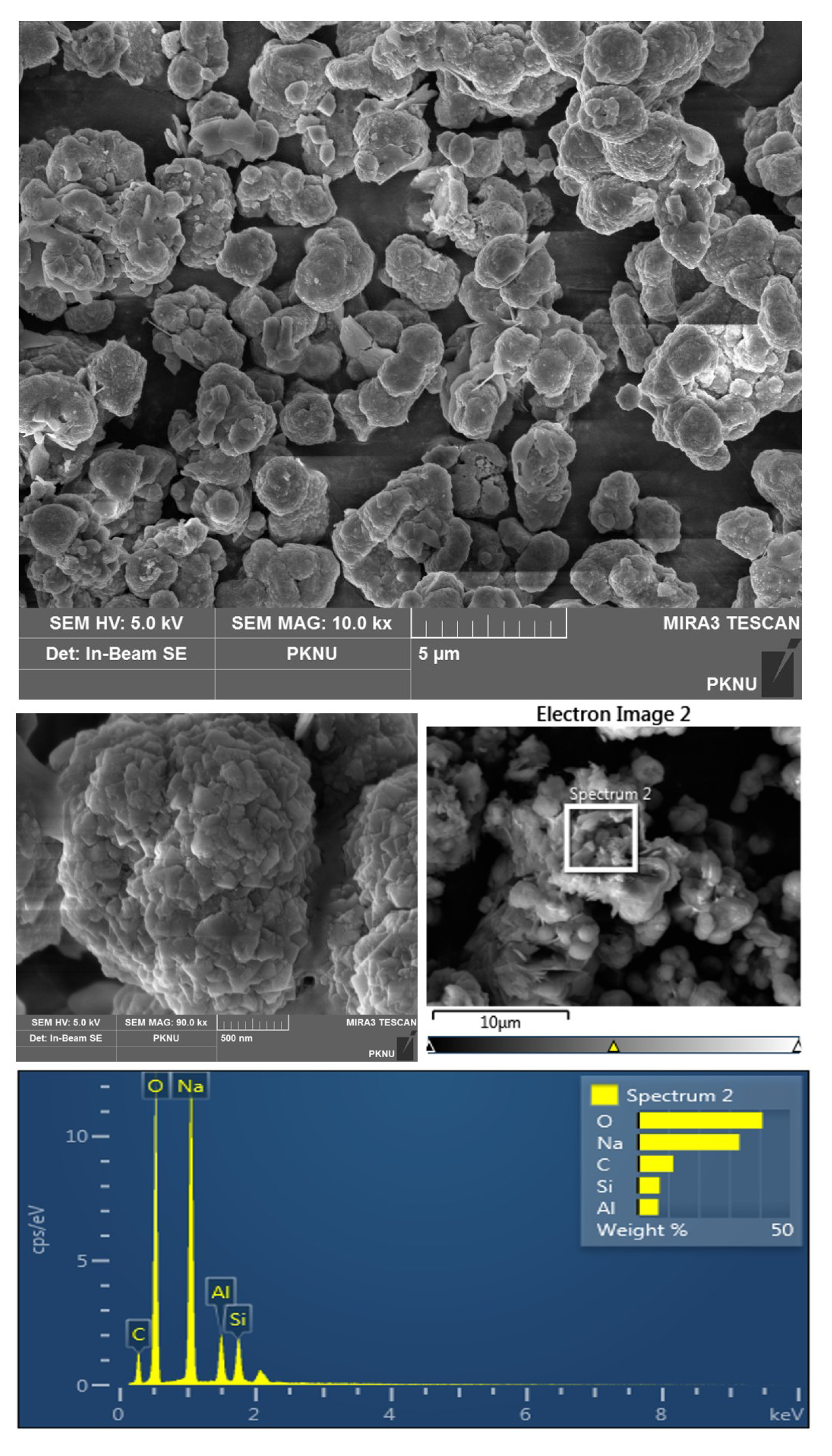
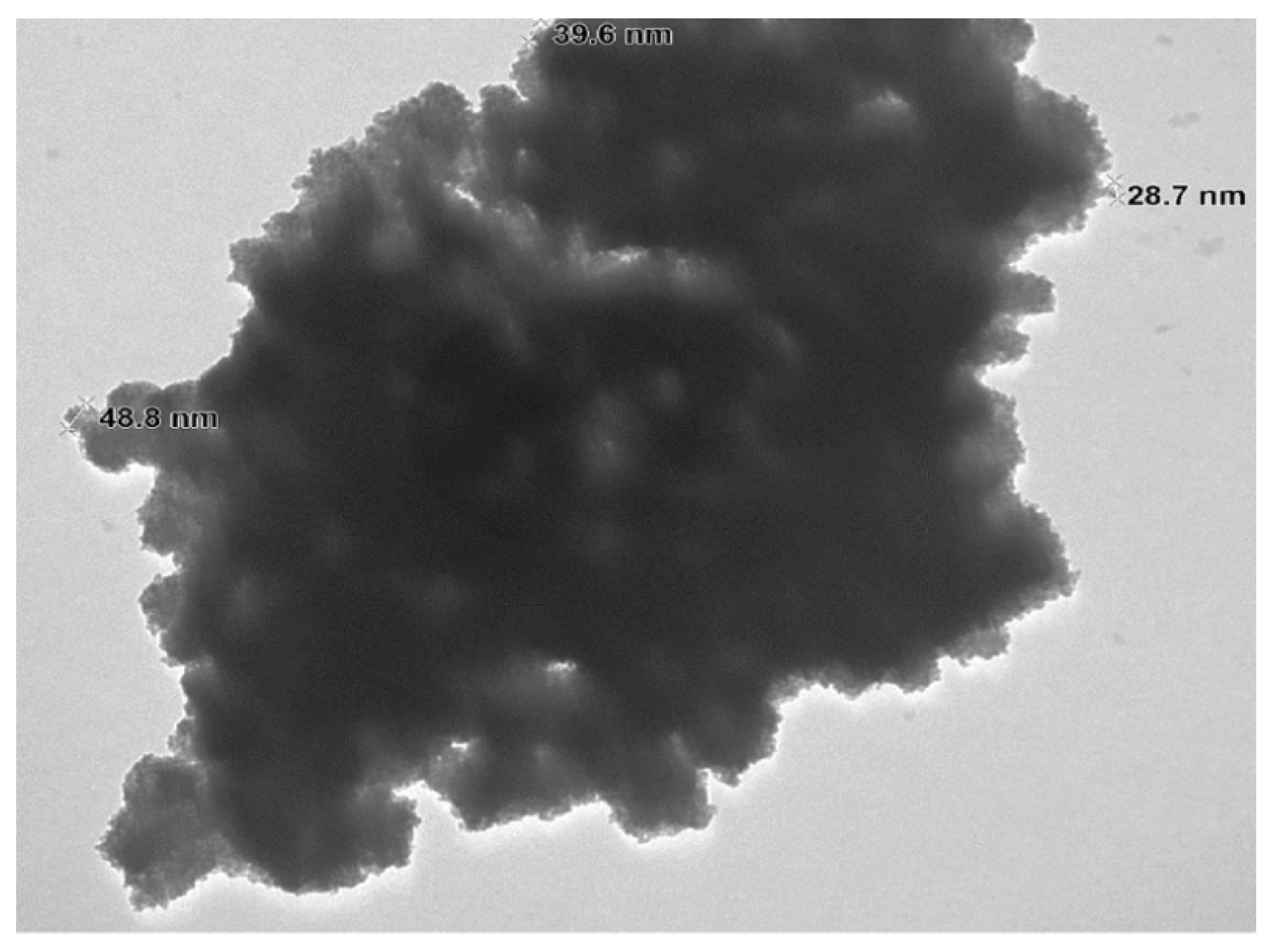
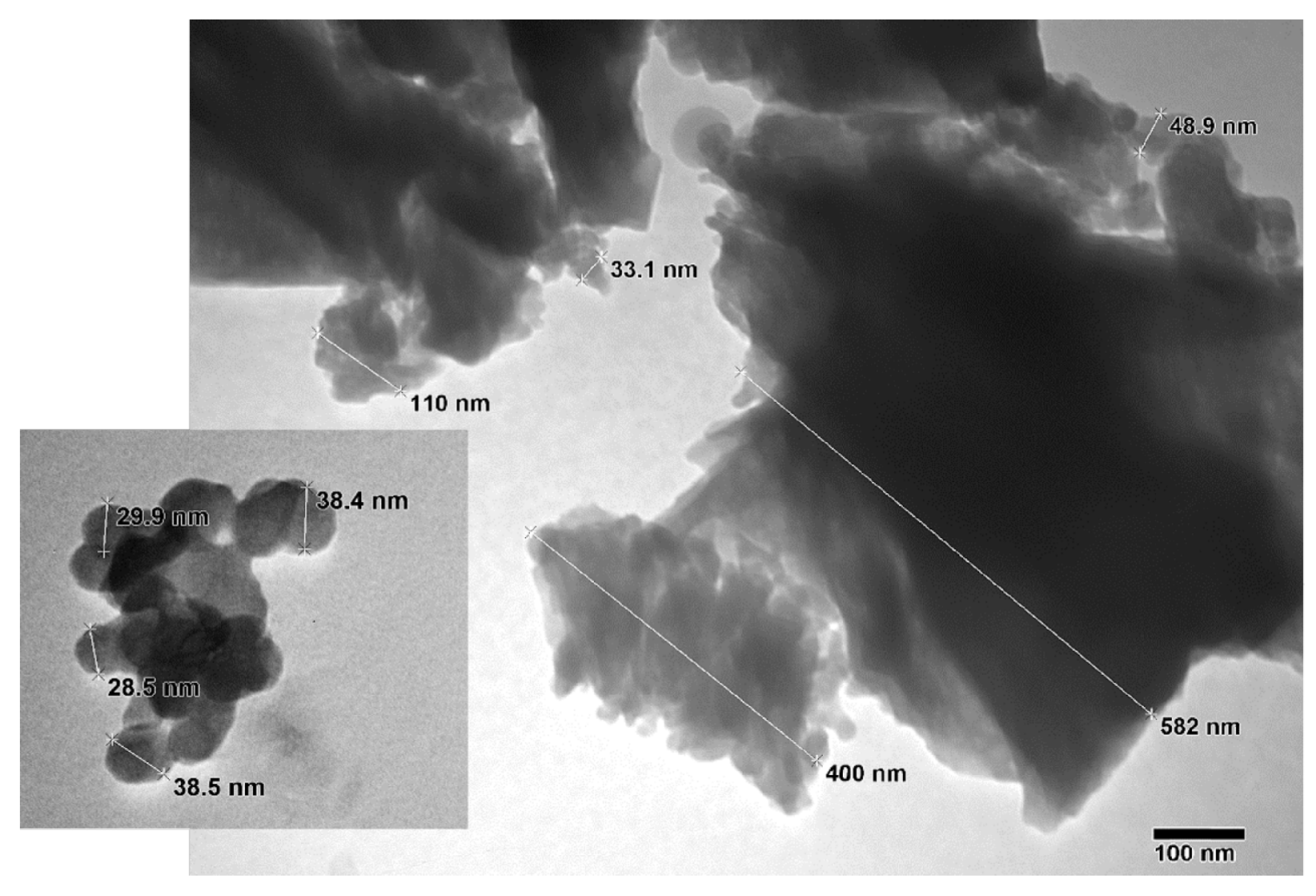
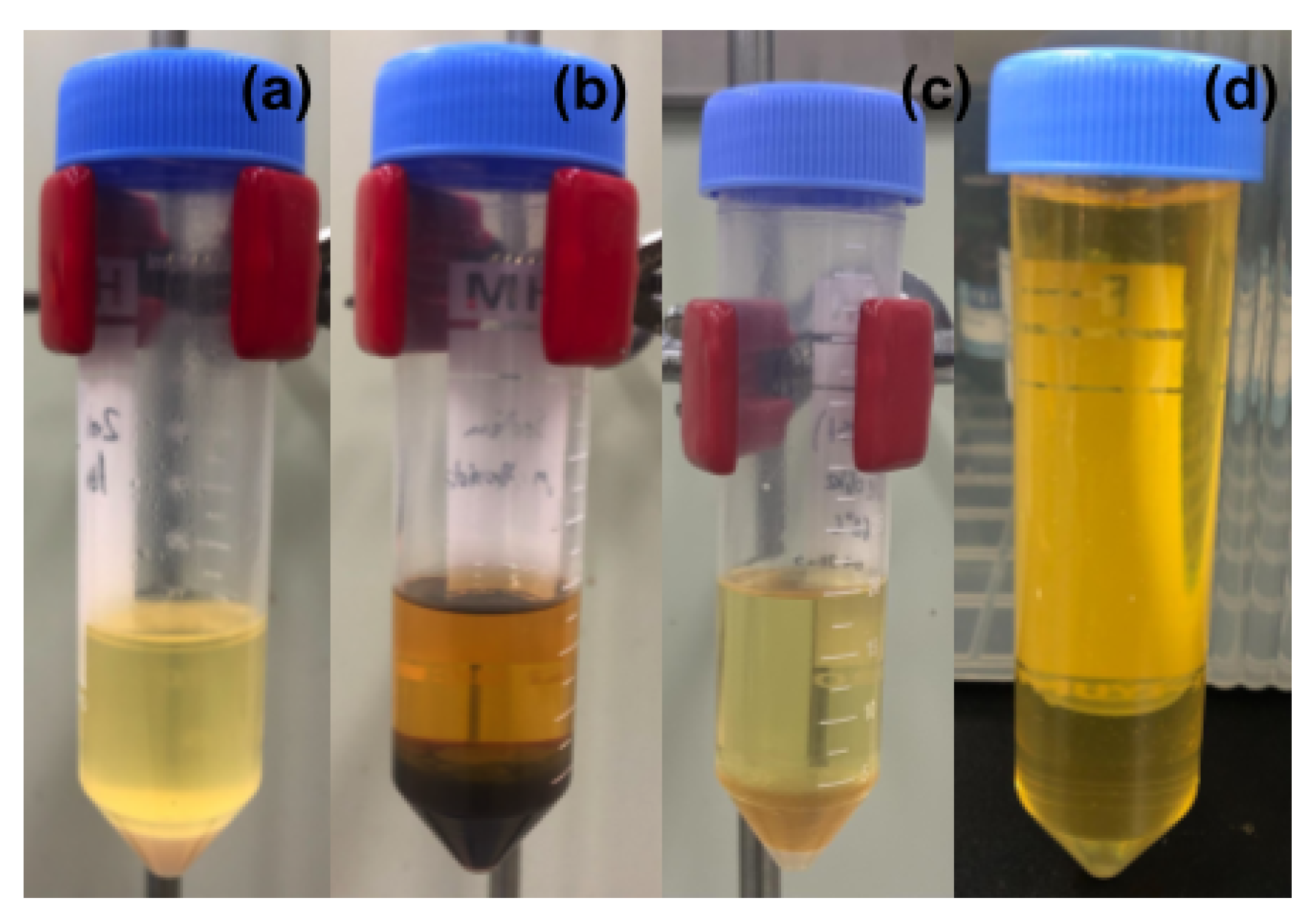

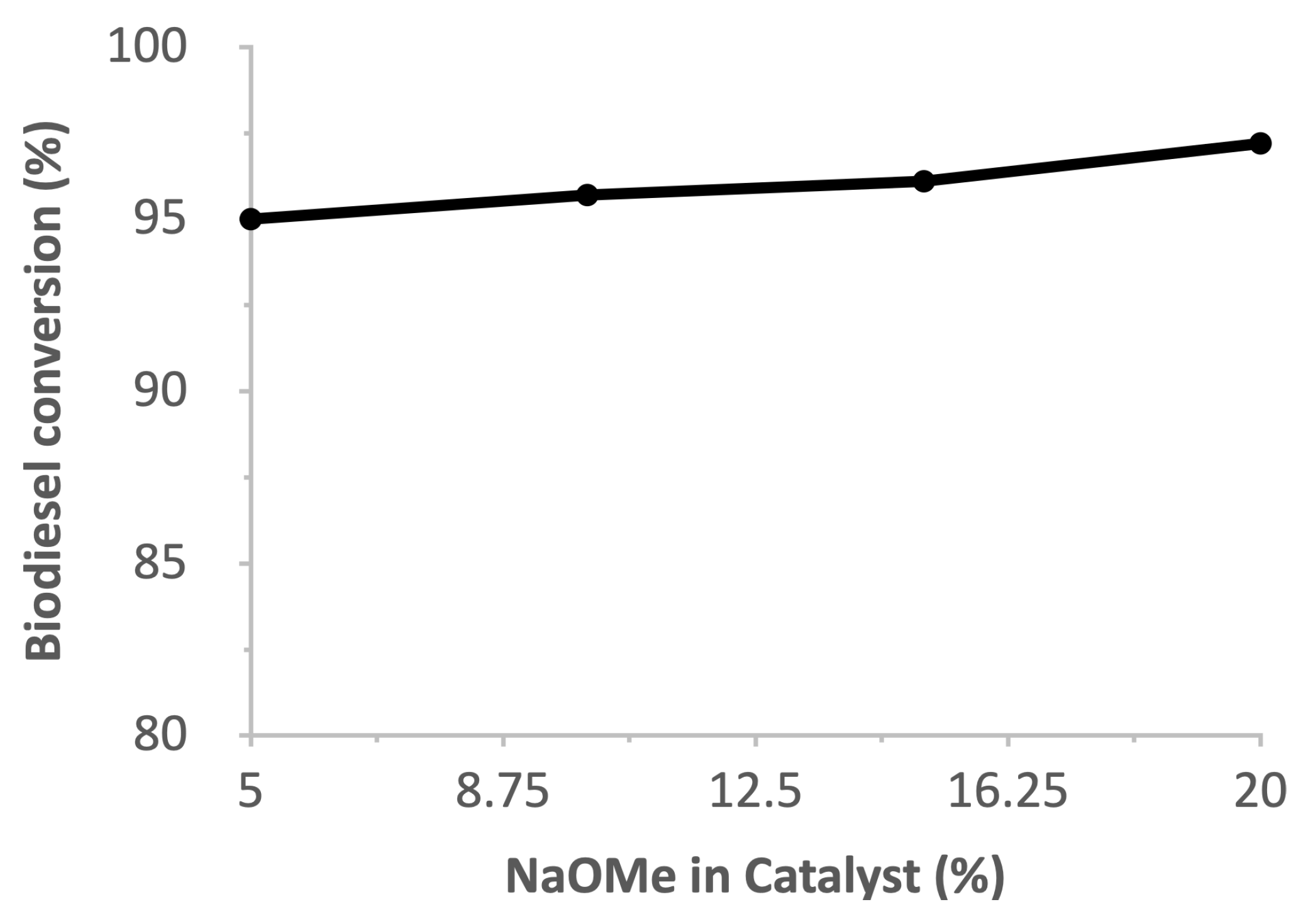

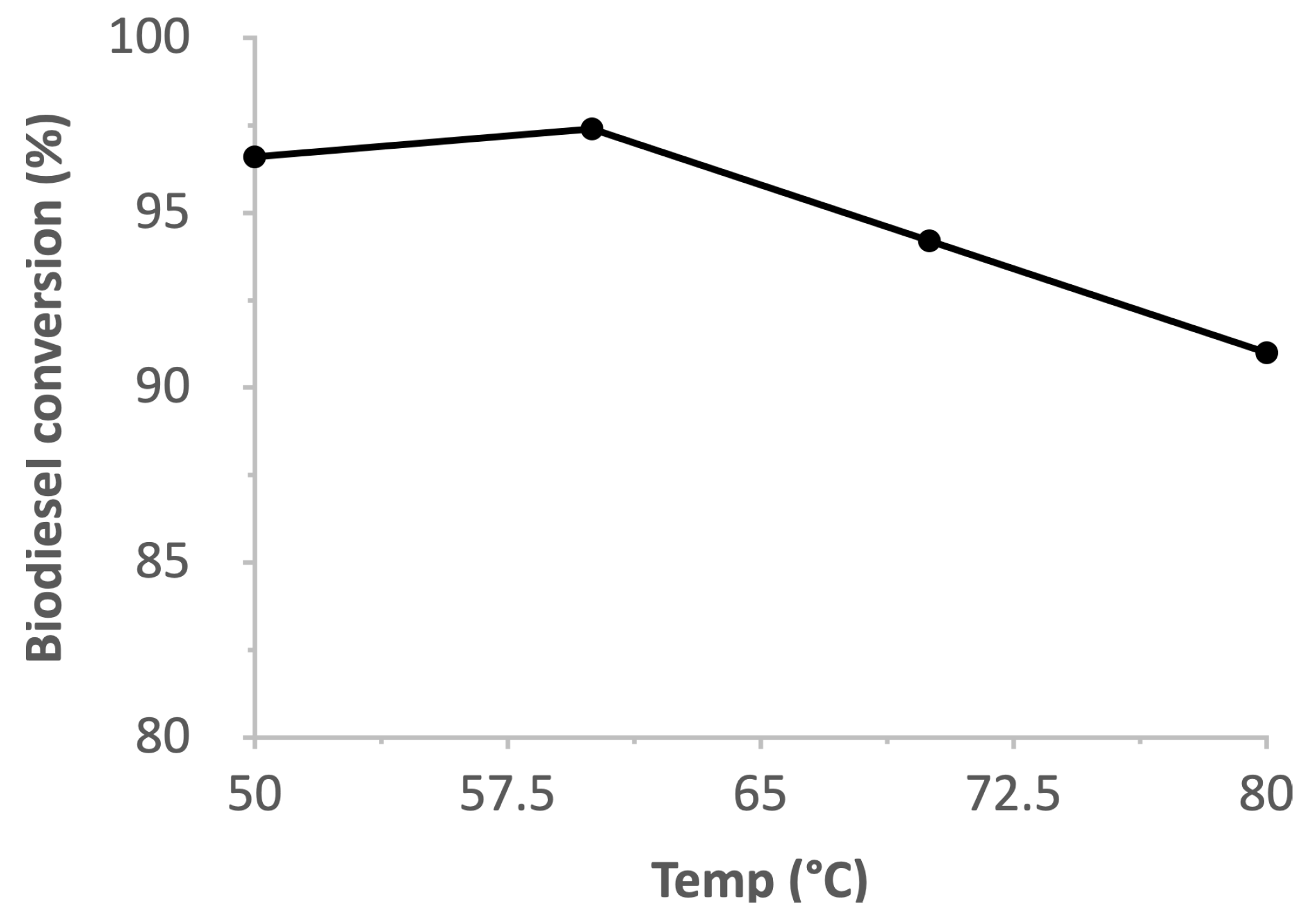



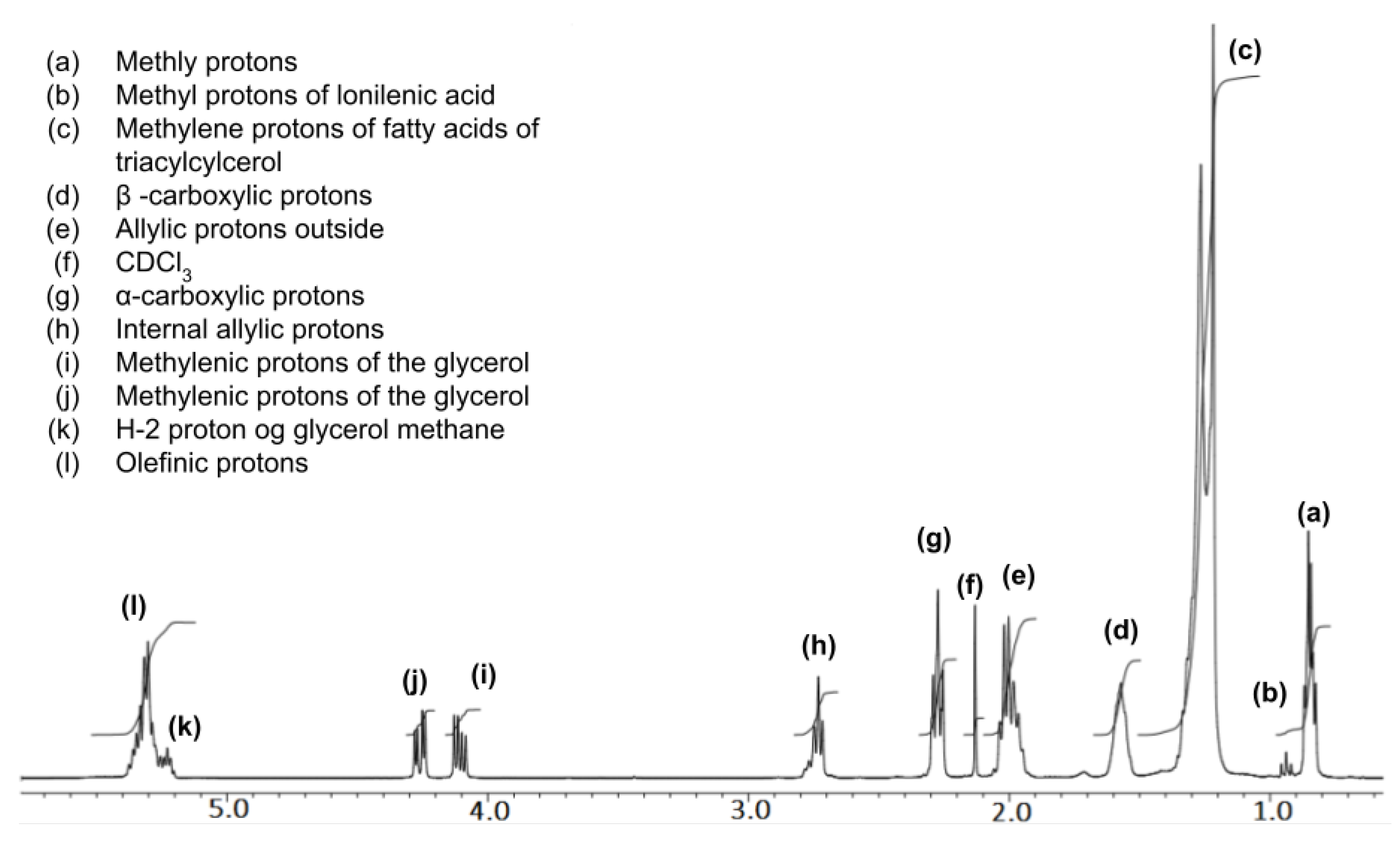


| Characterization Technique | Zeolite | NaOMe/Zeolite |
|---|---|---|
| BET surface | 194.780 m2/g | 157.274 m2/g |
| Pore volume | 0.6551 cm3/g | 0.606 cm3/g |
| Pore size | 4.939 Å | 5.692 Å |
| DFT pore volume | 0.159 cm3/g | 0.139 cm3/g |
| DFT surface area | 62.989 m2/g | 54.489 m2/g |
| Half pore width | 15.846 Å | 15.846 Å |
| Chemical Components | C | O | Na | Al | Si |
|---|---|---|---|---|---|
| Zeolite (wt%) | 3.63 | 38.89 | 18.98 | 18.76 | 19.74 |
| NaOMe/Zeolite (wt%) | 11.66 | 40.89 | 33.41 | 6.82 | 7.21 |
| Sr. No. | Catalyst | Temp. (°C) | Oil/Methanol (Molar Ratio) | Time (min.) | Estimated Yield (%) |
|---|---|---|---|---|---|
| 1 | Zeolite | 60 | 16:1 | 180 | <10 |
| 2 | NaOMe | 60 | 16:1 | 180 | 91 |
| 3 | NaOMe/zeolite | 60 | 16:1 | 180 | 95 |
| Sample | Flow Time (sec.) | Meantime (t) sec. | K | Viscosity (mm2/s) (v = Kt) | ||
|---|---|---|---|---|---|---|
| 1 | 2 | 3 | ||||
| Biodiesel | 1255.3 | 1277.63 | 1296.77 | 1276.57 | 0.004 | 5.10628 |
Disclaimer/Publisher’s Note: The statements, opinions and data contained in all publications are solely those of the individual author(s) and contributor(s) and not of MDPI and/or the editor(s). MDPI and/or the editor(s) disclaim responsibility for any injury to people or property resulting from any ideas, methods, instructions or products referred to in the content. |
© 2023 by the authors. Licensee MDPI, Basel, Switzerland. This article is an open access article distributed under the terms and conditions of the Creative Commons Attribution (CC BY) license (https://creativecommons.org/licenses/by/4.0/).
Share and Cite
Argaw Shiferaw, K.; Mathews, J.M.; Yu, E.; Choi, E.-Y.; Tarte, N.H. Sodium Methoxide/Zeolite-Supported Catalyst for Transesterification of Soybean Waste Cooking Oil for Biodiesel Production. Inorganics 2023, 11, 163. https://doi.org/10.3390/inorganics11040163
Argaw Shiferaw K, Mathews JM, Yu E, Choi E-Y, Tarte NH. Sodium Methoxide/Zeolite-Supported Catalyst for Transesterification of Soybean Waste Cooking Oil for Biodiesel Production. Inorganics. 2023; 11(4):163. https://doi.org/10.3390/inorganics11040163
Chicago/Turabian StyleArgaw Shiferaw, Kidist, Joshua Manoj Mathews, Eunsu Yu, Eun-Young Choi, and Naresh Hiralal Tarte. 2023. "Sodium Methoxide/Zeolite-Supported Catalyst for Transesterification of Soybean Waste Cooking Oil for Biodiesel Production" Inorganics 11, no. 4: 163. https://doi.org/10.3390/inorganics11040163




